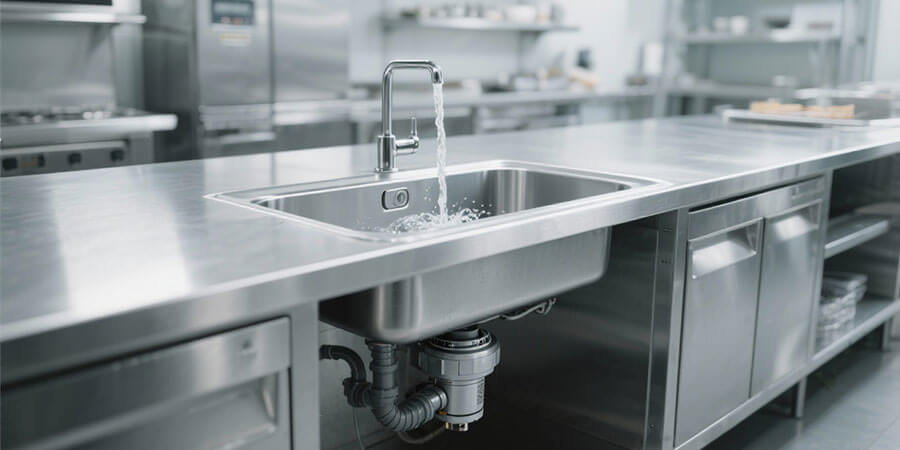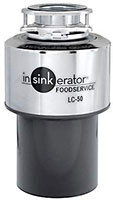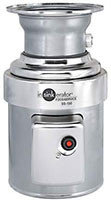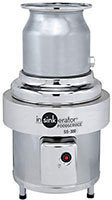Commercial Kitchen Garbage Disposer Guide

Essential guide to selecting and installing commercial garbage disposers for restaurants
These are ideal for kitchen use. They are not too big nor too small and do their job without too much hassle. A disposer that has between 1 and 3 horsepower is suitable for use at a small diner, for example.
At-a-Glance
- Duty Classes: Light (1 HP, 50-100 meals), Medium (2-3 HP, 200-400 meals), Heavy (5+ HP, 500-1,000 meals)
- Motor Types: Continuous feed for steady waste streams, batch feed for water conservation
- Key Selection Factors: Daily meal volume, waste density, plumbing infrastructure, electrical capacity
- Installation: Professional plumbing required, proper drain slope (1/4" per foot), backflow prevention
- Maintenance: Daily flushing, weekly cleaning, professional service every 6-12 months
- Cost Range: $1,000-$15,000+ depending on capacity and features
- ROI: 6-18 month payback through labor savings and reduced plumbing costs
The Business Case & Compliance
Why Restaurants Need Commercial Disposers
Restaurant kitchens generate significant food waste that creates operational challenges. Commercial garbage disposers solve this by grinding waste into sewer-safe slurry, eliminating waste buckets and preventing common kitchen problems.
Key Benefits & Compliance
Operational Advantages:
- Labor Savings: Eliminates manual waste handling, saving 15-30 minutes per shift
- Sanitation: Prevents pest attraction and maintains cleaner kitchen environments
- Cost Reduction: Cuts landfill fees by 20-40% and avoids $1,000-$5,000 in drain cleaning costs
Regulatory Requirements:
- FOG Regulations: Grease interceptors required in many jurisdictions
- Health Codes: Proper waste disposal prevents contamination and fines
- Plumbing Standards: Must meet local building and safety codes
- Documentation: Maintenance records required for inspections
Environmental Benefits
Commercial disposers contribute to sustainable waste management by diverting organic waste from landfills to wastewater treatment systems. This reduces the volume of solid waste requiring disposal while ensuring food scraps are processed through municipal sewer systems designed for organic matter.
Garbage Disposer Categories & Types
Understanding Duty Classes
Commercial disposers are categorized by horsepower and capacity to match different restaurant sizes and waste volumes. The right duty class depends on your daily meal count and waste composition.
| Duty Class: | Horsepower: | Daily Capacity: | Best Applications: | Waste Handling: |
| Light Duty | 1/2 - 1 HP | 50-100 meals | Coffee shops, delis, small cafes | Produce scraps, coffee grounds |
| Medium Duty | 2 - 3 HP | 200-400 meals | Fast-casual, cafes, small hotels | Mixed plate waste, small bones |
| Heavy Duty | 5+ HP | 500-1,000 meals | Full-service, hotels, catering | Large bones, dense foods |
Key Considerations:
- Meal Count: Base selection on peak day requirements, not averages
- Waste Density: Dense foods (bones, bakery items) require higher horsepower
- Usage Patterns: Continuous vs. intermittent operation affects motor type selection
- Future Growth: Choose equipment that can handle 25% capacity increase
Motor Type Selection
Continuous Feed: Best for busy kitchens with steady waste streams. Runs continuously while waste is present, ideal for high-volume operations (200+ meals daily) but uses more water.
Batch Feed: Perfect for intermittent use or water conservation. Processes waste in batches with lower water consumption (up to 50% savings) but requires operator management.
Critical Sizing Considerations

Calculating Your Waste Volume
Accurate sizing begins with a realistic assessment of your daily waste generation. Most restaurants underestimate their disposal needs, leading to frequent clogs and system failures.
Daily Meal Impact: Calculate waste based on your service style and menu composition. A 200-seat restaurant serving lunch and dinner might generate 400-600 meals daily, but waste volume varies significantly by cuisine.
Service Type Considerations:
- Breakfast-focused: 30-50% of daily waste comes from coffee grounds, fruit trimmings, and pastry scraps
- Lunch/Dinner service: 60-80% of waste from plated meals, vegetable prep, and plate scraps
- Buffet operations: Generate 100-150% more waste due to portion waste and self-service
- Catering events: Variable waste depending on menu complexity and portion sizes
Understanding Waste Composition
Different menu styles create vastly different waste profiles that affect disposer requirements:
| Menu Type: | Waste Characteristics: | Disposer Requirements |
| Produce-Heavy (salads, vegetarian) | High volumes of fibrous waste like celery, carrots, potato skins | Can tangle in disposer impellers; requires good grinding power |
| Meat-Focused | Dense waste with bones and cartilage | Requires powerful motors (5+ HP) to grind effectively |
| Bakery/Dessert | Starchy waste that can gelatinize in drains | Needs thorough grinding and flushing to prevent buildup |
| Seafood | Shells, scales, tough connective tissue | Demands industrial-strength grinding power (7.5+ HP) |
Infrastructure Requirements
| System: | Requirements: | Key Considerations: |
| Plumbing | 1.5-2" diameter drain lines, minimum 1/4" per foot slope | Assess existing drain performance and length; may need upgrades |
| Water Supply | 1-2 GPM flow rate, 20-80 PSI pressure, cold water (40-60°F) | Backflow prevention required in many areas |
| Electrical | Dedicated circuit required | Light duty (6-10 amps), Medium (15-20 amps), Heavy (25-35 amps) |
Installation Best Practices
Strategic Location Planning
The success of your disposer system depends heavily on thoughtful placement within your kitchen workflow.
Primary Integration Points:
- Dish Return Stations: Most common location where staff naturally scrape plates
- Prep Sinks: Perfect for vegetable trimmings and food preparation waste
- Bar Sinks: Ideal for fruit garnishes and beverage-related waste
Kitchen Layout Optimization:
- Equipment Proximity: Position near dishwashers and food prep areas to minimize travel
- Traffic Flow: Place to enhance rather than disrupt kitchen workflow patterns
- Maintenance Access: Ensure technicians can easily reach the unit for servicing
- Noise Management: Position away from customer seating and quiet work areas
Mounting Configuration Options
Direct Sink Flange: Most common for single sinks - mounts directly under drain, cost-effective but requires sink modification.
Cone/Trough Systems: For high-volume operations - handles multiple users, requires dedicated space but more efficient for busy kitchens.
In-Line Remote: For flexible placement - hides unit away from sink area, best for space-constrained or customer-facing locations.
Professional Plumbing Integration
While basic disposer installation might seem straightforward, professional plumbing work ensures reliable long-term performance and code compliance.
Drain System Upgrades: Existing drain lines may need upgrades to handle the increased flow and solids from disposer discharge. This often includes larger diameter pipes and proper slope to prevent waste settling.
Ventilation & Air Gaps: Many jurisdictions require air gaps or backflow preventers to prevent sewer gases from entering the building. Proper P-trap installation is essential for drainage and odor control.
Grease Management: Operations with significant grease production may need grease interceptors upstream of the disposer to prevent buildup and maintain flow.
Water Supply Integration: The disposer requires a dedicated water supply with proper flow control. Consider water quality filtration if hard water or minerals could affect performance.
Selection Decision Framework
Key Decision Steps
- Assess Waste Volume: Calculate peak daily meal count and consider menu composition (dense foods require more power)
- Evaluate Infrastructure: Check plumbing (1.5-2" drains, proper slope), electrical capacity, and available space.
- Choose Duty Class: Light (1/2-1 HP) for <200 meals, Medium (2-3 HP) for 200-500 meals, Heavy (5+ HP) for 500-1,000 meals.
- Select Features: Choose continuous vs. batch feed, mounting style, and additional options based on your specific needs.
Maintenance & Care Requirements

Proper maintenance ensures your disposer operates efficiently and extends its service life. Most issues can be prevented with regular care.
Daily Maintenance Checklist
Establish a simple daily maintenance routine to keep your disposer running smoothly:
- Flush with cold water (30-60 seconds after each use to clear waste particles)
- Visual inspection (listen for unusual noises, check for excessive vibration)
- Clean drain screens (remove and clean any removable screens or filters)
- Odor prevention (use enzymatic drain cleaners weekly to break down organic matter)
Weekly Maintenance Checklist
Set aside time each week for thorough cleaning and inspection:
- Disassemble components (remove and clean all removable parts with warm, soapy water)
- Lubricate bearings (apply food-grade lubricant to reduce friction and wear)
- Verify performance (test under normal load to ensure proper grinding and drainage)
- Document usage (keep log of usage patterns and any unusual occurrences)
Professional Servicing Schedule
While daily and weekly maintenance handles most needs, professional servicing ensures optimal long-term performance:
| Frequency: | Service Type: | Purpose: |
| Monthly | Professional inspection | Evaluate wear components and electrical connections |
| Semi-Annual | Deep service | Bearing lubrication and seal replacement to prevent leaks |
| Annual | Comprehensive inspection | Complete teardown and inspection of all components |
| As Needed | Emergency repairs | Address unusual noises, reduced performance, or safety concerns |
Regulatory & Safety Considerations
Commercial disposers must comply with multiple regulatory requirements and safety standards. Understanding these requirements ensures smooth operation and avoids costly violations.
Health Department Compliance:
Restaurant operations must meet strict health department standards for waste disposal and sanitation.
FOG Regulations - Many jurisdictions require grease interceptors or separators to prevent fats, oils, and grease from entering sewer systems and causing blockages.
Waste Stream Separation - Ensure food waste doesn't contaminate other waste streams or create cross-contamination risks.
Sanitization Requirements - Some operations require hot water sanitization to meet health codes for food contact surfaces.
Maintenance Documentation - Keep records of cleaning schedules and maintenance activities for health inspections.
Plumbing Code Requirements:
Local plumbing codes dictate how disposers integrate with existing systems and protect public health.
Backflow Prevention - Install approved backflow preventers to prevent sewer contamination of potable water systems.
Drainage Standards - Meet minimum pipe diameter and slope requirements for proper waste flow and drainage.
Ventilation Systems - Proper venting prevents sewer gases from entering the building and affecting indoor air quality.
Service Accessibility - Ensure maintenance personnel can safely access disposer components for servicing.
Essential Safety Features:
Modern commercial disposers include multiple safety features to protect users and prevent accidents.
Overload Protection - Automatic shutoff prevents motor damage if the disposer becomes jammed with tough materials.
Emergency Stop Controls - Manual shutoff switches allow immediate stopping in case of issues or emergencies.
Sound Insulation - Reduces noise levels to protect employee hearing and maintain comfortable work environments.
Guard Systems - Protective covers and guards prevent accidental contact with moving parts during operation.
Cost Analysis & ROI
Understanding the true cost of a commercial disposer goes beyond the purchase price. Consider both initial investment and long-term operating expenses.
Investment Ranges by Capacity
Commercial disposer costs vary significantly based on horsepower and construction quality.

Light Duty Food Disposers: Basic 1/2-1 HP units typically range from $1,000-$2,000, suitable for small operations with simple waste streams.

Medium Duty Food Disposers: 2-3 HP models for standard restaurant applications cost $2,000-$4,000, offering reliable performance for most establishments.

Heavy Duty Food Disposers: 5+ HP units designed for demanding operations range from $4,000-$7,000, with industrial-grade components.
Ongoing Operating Expenses
Factor in these recurring costs when calculating total cost of ownership.
Water Consumption: Most disposers use 1-3 gallons per minute during operation, with water-saving models reducing this by up to 50%.
Energy Usage: Electrical consumption ranges from 6-50 amps depending on horsepower, with three-phase models being more efficient for larger units.
Professional Maintenance: Annual servicing costs $200-$500, including parts and labor for routine inspections.
Replacement Components: Wear parts like bearings and seals typically cost $100-$300 when replacement is needed.
ROI and Payback Analysis
Calculate return on investment by considering both cost savings and operational improvements:
| Benefit Category: | Savings/Impact: | Details: |
| Labor Efficiency | Save 15-30 minutes per shift | Streamlined waste handling and reduced cleanup time |
| Waste Management | Reduce landfill fees by 20-40% | Converting waste to sewer-safe slurry |
| Preventive Maintenance | Avoid $1,000-$5,000 in emergency costs | Proper waste processing prevents drain cleaning expenses |
| Payback Period | 6-18 months typical | Systems pay for themselves through labor savings and reduced disposal costs |
Example Scenarios:
- Quick-Service Restaurant (200 meals/day): $3,000 investment pays back in 8-12 months
- Full-Service Restaurant (400 meals/day): $5,000 investment pays back in 6-10 months
- High-Volume Operation (800+ meals/day): $8,000+ investment pays back in 10-18 months
Troubleshooting Common Issues
Most Common Problems & Solutions
Slow Drainage: Check for clogs in discharge line or clean removable screens. Ensure proper 1/4" per foot drain slope.
Unusual Noises/Vibrations: May indicate worn bearings or loose mounting. Schedule professional inspection immediately.
Frequent Jamming: Avoid large bones, fibrous materials, or utensils. Use strainers and educate staff on proper waste types.
Leakage: Verify all connections are sealed properly and sink flange is correctly installed.
Preventive Maintenance
Daily: Flush with cold water after each use, clean removable screens, quick visual inspection.
Weekly: Deep clean removable parts, lubricate bearings, verify performance.
Professional: Schedule servicing every 6-12 months for optimal performance and extended equipment life.
Kitchen Integration & Placement
Dishwashing Areas: Position near dish return stations for immediate plate scraping and waste processing.
Prep Stations: Ideal for produce-heavy operations, handling vegetable trimmings and food preparation waste.
Workflow Optimization: Place to enhance rather than disrupt kitchen traffic flow, with easy maintenance access.
Future-Proofing Your Investment
Scalability: Choose units rated for 25-50% more capacity than current needs to handle future growth and menu changes.
Advanced Features: Consider water-saving controls, energy-efficient motors, and digital monitoring for long-term efficiency.
Professional Installation Recommendations
While some disposers can be installed by experienced maintenance staff, professional installation ensures optimal performance and warranty protection.
Critical Installation Expertise
Professional installers bring specialized knowledge that ensures long-term reliability.
Advanced Plumbing Skills: Proper drain line modifications, P-trap installation, and backflow prevention require licensed expertise.
Electrical Safety Compliance: Correct wiring, circuit protection, and grounding meet commercial electrical codes.
Code Compliance Assurance: Professional installers ensure all local building, plumbing, and health department requirements are met.
Warranty Protection: Manufacturer warranties typically require professional installation to remain valid.
Installation Process
Professional Installation: Required for warranty coverage and code compliance. Includes utility verification, system testing, and staff training.
Shop Commercial Garbage Disposals
Browse our selection of commercial garbage disposers:
- Light Duty Disposers - 1/2-1 HP units for smaller operations
- Medium Duty Disposers - 2-3 HP units for most restaurants
- Heavy Duty Disposers - 5+ HP units for demanding applications
Need help selecting the right disposer? Contact our equipment specialists for personalized recommendations based on your menu, volume, and existing infrastructure.
Frequently Asked Questions
How do I determine the right size disposer for my restaurant?
Calculate based on daily meal count and waste density. Light duty (1 HP) for under 200 meals/day, medium duty (2-3 HP) for 200-500 meals/day, heavy duty (5+ HP) for 500-1,000 meals/day. Consider menu complexity - dense foods like bones require more power.
Can I install a commercial disposer myself?
Professional installation is strongly recommended. Improper installation can void warranties, create plumbing issues, and violate local codes. Licensed plumbers ensure proper electrical, plumbing, and mounting work.
How often should commercial disposers be serviced?
Schedule professional servicing every 6-12 months depending on usage. Daily cleaning, weekly deep cleaning, and monthly professional inspections help prevent major issues and extend equipment life.
What causes disposer jams and how can I prevent them?
Jams typically result from oversized food items, dense materials like bones, or foreign objects. Prevent by educating staff on appropriate waste types, using strainers, and scheduling regular maintenance.
What's the difference between continuous feed and batch feed disposers?
Continuous feed units run steadily while waste is present, ideal for steady waste streams. Batch feed units process waste in batches with the cover closed, using less water but requiring more operator attention.
Related Guides & Resources
Related Equipment Guides
- [Commercial Dishwashers Guide] - Complete dishwashing equipment selection
- [Commercial Sinks Guide] - Sink selection and installation guide
Maintenance Resources
- [Commercial Equipment Maintenance] - Care and servicing schedules
- [Commercial Equipment Troubleshooting] - Common equipment issues and solutions
Share This!